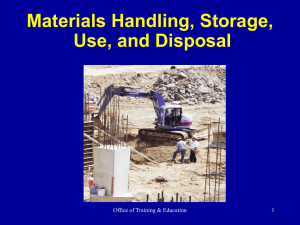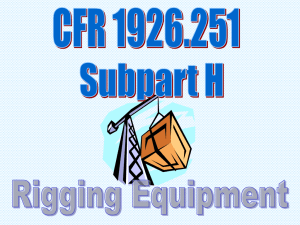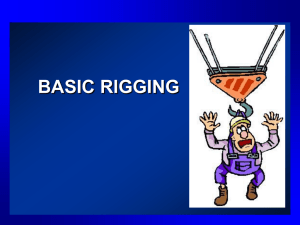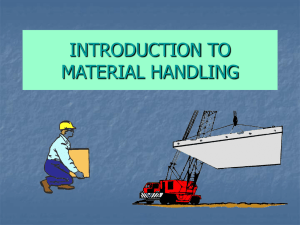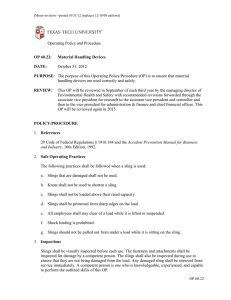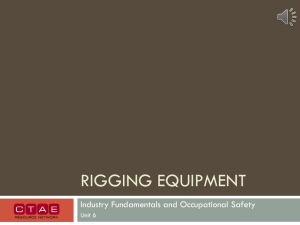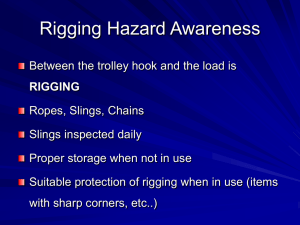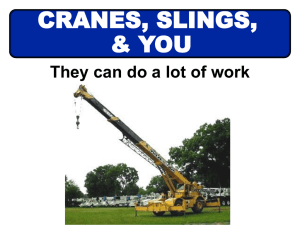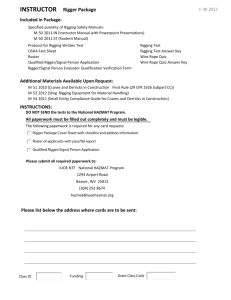Week 9 Power Points
advertisement
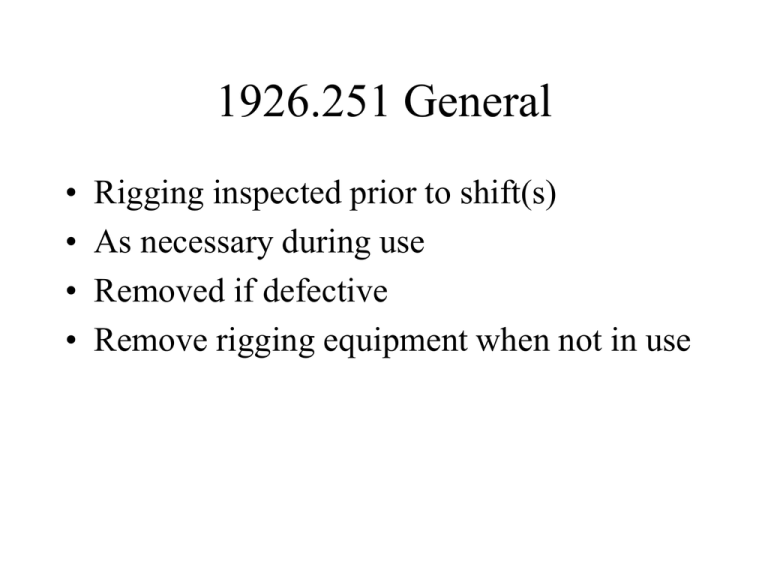
1926.251 General • • • • Rigging inspected prior to shift(s) As necessary during use Removed if defective Remove rigging equipment when not in use 1926.251 Scope • Covers slings and hoisting material handling equipment – – – – Alloy steel chain, Wire rope, Metal mesh, Natural or synthetic fiber rope (conventional three strand construction), and – Synthetic web (nylon, polyester, and polypropylene). Types of Slings Synthetic Fiber Metal Mesh Alloy Steel Wire Rope 1926.251(b) Alloy Steel Chain • Permanently affixed durable identification stating – – – – Size, Grade, Rated capacity, and Sling manufacturer. • All attachments capacity at least equal to chain 1926.251(b) Alloy Steel Chain • CP inspections made & based on: – – – – (A) Frequency of sling use; (B) Severity of service conditions; (C) Nature of lifts being made; and (D) Experience gained on the service life of slings used in similar circumstances. • Such inspections at least once a year • Documented & available 1926.251(c) Wire Rope • Follow manufacturers safe working load recommendations, or Tables H - 3 through H - 14 1926.251(c) Wire Rope • End strands covered or blunted 1926.251(c) Wire Rope • Wire rope shall not be used if, in any length of eight diameters, the total number of visible broken wires exceeds 10 percent of the total number of wires, or if the rope shows other signs of excessive wear, corrosion, or defect. 1926.251(c) Wire Rope • U-bolt applied so that the "U" section is in contact with the dead end of the rope. • Use Table H - 20 to determine number and spacing of clips • Never shorten slings with knots or bolts • Protect slings from sharp edges (Not for bridles, slings) U-bolt wire rope clips Never saddle a dead horse 1926.251(c) Wire Rope • Never apply a shock load when lifting • Never place finger between sling & load when tightening 1926.251(d) Natural & Synthetic Rope • Tables H - 15 through H - 18 apply • Knots not used instead of splices • Remove from service if: – – – – Abnormal wear. Powdered fiber between strands. Broken or cut fibers. Discoloration or rotting. 1926.251(e) Synthetic Webbing • (e) Synthetic webbing (nylon, polyester, and polypropylene). • (1)Each synthetic web sling marked or coded to show: – (i) Name or trademark of manufacturer. – (ii) Rated capacities for the type of hitch. – (iii) Type of material. 1926.251(e) Synthetic Webbing • Don’t use around acids or phenolics • Remove from service if: – Acid or caustic burns – Melting or charring of any part of the sling surface; – Snags, punctures, tears or cuts; – Broken or worn stitches; or – Distortion of fittings. 1926.251 (f) Shackles and hooks. • Use Table H - 19 • Use manufacturers recommendations • Tested to twice the intended safe working load before they are initially put into use. Maintain a record of the dates and results of such tests. Rigging Safety • Between the trolley hook and the load is RIGGING • Ropes, Slings, Chains • OSHA-Slings inspected daily • Proper storage when not in use • Suitable protection of rigging when in use (items with sharp corners, etc..) Rules for Rigging Safety • 1. Know the weight of the load • 2. Know the center of gravity of the load. • 3. Make load attachment above the center of gravity of the load. • 4. Select hitch that will hold and control. • 5. Know the rated capacity of slings and hardware. Rules for Rigging Safety • 6. Select sling best suited for load. • 7. Inspect all rigging before the lift. • 8. Protect sling from sharp surfaces. Rules for Rigging Safety • 9. Proper calculation of increased tension caused by sling angles (on all rigging components!). • 10. Allow for D/d ratio on all slings. • 11. Calculate reductions when using choker hitch. Rules for Rigging Safety • 12. Keep personnel clear from lift area. • 13. Lift load a few inches then check rigging. • 14. Know limitations of all lifting devices used. • 15. Lift slowly and stop slowly. Hooks • Hooks are used for lifting, towing, pulling and securing. • Two general classifications: – Sling Hooks: to which load or force is applied to the base (bowl saddle) – Grab Hooks: contain a throat or slot of uniform width for securing on the link of a chain, usually to form a chain loop for securing the load Hooks • Do not exceed the working load limit • Only use alloy heat treated hooks for overhead lifting • Do not tip load or use the hook in any manner for which it was not intended • Do not shock load or dynamic load • Never apply load to hook latches, latches are only to retain slack chains and slings Basics of Hook Inspections • • • • Wear Deformation Cracks Sharp Nicks Check throat opening Check for wear & deformation Check for twisting Check for wear & cracks Max twist 10° Avoid: •Side load •Back load •Tip load Hoist Chains • • • • • • • Four grades: – Grade 28 General Utility Chain – Grade 43 High Test Chain – Grade 70 Binding Chain – Grade 80 Alloy Steel Chain: The only one used for overhead lifting! Ranges in size from 7/32 to 11/4 link diameter. Check for wear, gouges, stretch, shearing Inspection is LINK by LINK Twisted link extremely unsafe Use with grab hooks Tags: should be on every chain: Size, Grade, Capacity Hoist Chains • Hoist load chains do not stretch (they wear) • Sling chains chain stretch 10 - 15 % before failure • Grades are indicated on side of link Outside of the link barrels are exposed to damage from foreign objects, on straight portion. These surfaces are in compression, so reduces harmful effect. Tensile stress areas are protected by chain geometry. Gouges in areas of tensile stress are of greatest concern., especially if they are perpendicular to the direction of stress. The load on quadruple branch slings seldom have the load evenly distributed evenly among the four branches. For this reason sling charts for quad branch slings set the load limit for quad branch slings to the equivalent rating for a triple branch sling of the same type. Wire Core Center Strand Wire rope How to describe any wire rope A typical wire rope may be designated 6X25 FW PRF RLL XIP IWRC. This translates to: A 6 strand (6X25) of filler wire construction (FW). The grade of wire used is Extra Improved Plow Steel (XIP). The strands are preformed (PRF) in helical pattern before being laid Right lang (RLL) around an Independent Wire Rope Core (IWRC). Each strand contains 25 wires Strand Types of Hitches Calculating the load on sling legs • Divide the total load by the number of sling legs • This quotient is the load on each leg if vertical • Measure the sling from the load attachment point, to the point where it connects with the hook or lifting device; this is ‘L’ • Measure the vertical height from the top of the load to the hook or lifting device; this is ‘H’ • Divide the length of the leg by the height of the sling L H LOAD (Load Number of legs) X (L H) = Load each sling leg Example • Load = 120,000 pounds • 120,000 ÷ 4 load legs equals 30,000 pounds each leg if vertical hitch • Sling legs are 20 feet • Height from top of load to lifting device is 15 feet • 20 ÷ 15 = 1.33 • Load on each leg is 1.33 x 30,000 = 40,000 pounds 120,000 lb. Center of Gravity • A load is stable when: – The hook is directly above the center of gravity of the load • Estimate the center of gravity • Lift the load just enough to clear the ground • If the hook is not over the center of gravity the hook will travel to the center of gravity CG? Center of Gravity • If necessary, set the load down and adjust the rigging • If the load tips more than 3°, the rigging should be adjusted • The longer the sling legs, the more stable the load will be B A The longer set of sling legs (B) will improve load stability
